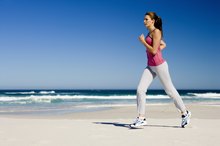What does fact checked mean?
At Healthfully, we strive to deliver objective content that is accurate and up-to-date. Our team periodically reviews articles in order to ensure content quality. The sources cited below consist of evidence from peer-reviewed journals, prominent medical organizations, academic associations, and government data.
- Centers for Disease Control and Prevention: Public Health Action Plan to Prevent Heart Disease and Stroke
- American Heart Association: Activities and Games
The information contained on this site is for informational purposes only, and should not be used as a substitute for the advice of a professional health care provider. Please check with the appropriate physician regarding health questions and concerns. Although we strive to deliver accurate and up-to-date information, no guarantee to that effect is made.
How Does Regular Exercise Affect the Arteries & Veins?
Your arteries and veins are the inner highways and byways that provide your body with the vital blood and nutrients it needs to keep you ticking over on a daily basis. If any of those arteries or veins become damaged or blocked, you’ll be at risk of developing heart disease, heart attack or stroke. It’s important that you do all you can to take care of your circulatory system, and exercise is an invaluable tool that can help you keep the road to a long and healthy life free and clear.
If you are experiencing serious medical symptoms, seek emergency treatment immediately.
The Highways of Your Body
Arteries and veins carry blood around your body. Arteries take blood away from your heart, delivering it to your organs and muscles. Veins bring blood back to your heart from those same organs and muscles. Your main arteries include the coronary arteries of your heart, the carotid and cerebral arteries of your brain, and the peripheral arteries, which stretch out into your limbs.
- Arteries and veins carry blood around your body.
- Arteries take blood away from your heart, delivering it to your organs and muscles.
Good Cop, Bad Cop
Herbs for Dissolving a Blood Clot
Learn More
If your veins and arteries become blocked by a buildup of cholesterol or fat, it’s harder for your heart to pump your blood to where it needs to be. Regular low- or moderate-intensity exercise is enough to reduce levels of LDL -- "bad" -- cholesterol and fat in your arteries and blood, preventing potential blockages (called plaque) and making it easier for blood to flow. More intense levels of exercise can raise HDL -- "good" -- cholesterol, which your body needs. HDL cholesterol doesn’t clog or block arteries.
- If your veins and arteries become blocked by a buildup of cholesterol or fat, it’s harder for your heart to pump your blood to where it needs to be.
- Regular low- or moderate-intensity exercise is enough to reduce levels of LDL -- "bad" -- cholesterol and fat in your arteries and blood, preventing potential blockages (called plaque) and making it easier for blood to flow.
Stretch and Breathe
The other main way that regular exercise affects your veins and arteries is that physical activity keeps your larger arteries flexible, meaning that they will be elastic enough to stretch and allow more blood to flow when it's needed, a little like a fire hose. As a result, your blood pressure is more likely to be sitting at normal levels during times of stress on the body instead of at dangerously elevated levels, easing the pressure on your heart and respiratory system.
Work That Body
How to Improve the Circulation in Your Calf, Ankle & Foot
Learn More
Regular low- or moderate-intensity exercise can include anything from a brisk walk to a swim or a bike ride. More intense levels of exercise include things like long distance running, high-energy dance or circuit training. Recognized and accredited scientific and health bodies such as the American Heart Association and the Centers for Disease Control and Prevention recommend at least 30 minutes of moderately intense exercise almost every day of the week to make sure that your body continues to keep you healthy and happy 12.
Staying Safe and Taking Care
Always consult your doctor before engaging in any moderate or intense levels of physical activity. If you lead a normally sedentary lifestyle and are not used to physical activity, start out slow with a simple walk. If you have a history of heart disease or stroke, regular exercise is beneficial in recovery and aids in the prevention of recurring problems.
Related Articles
References
Resources
Writer Bio
Steven Lowis is a teacher of metaphysics, as well as a writer covering a wide range of topics. He specializes in the areas of quantum theory, physics, biology, health and fitness, psychology, theology and philosophy. He has released a book titled "The Meaning of Life - Understanding Purpose and the Nature of Reality."







